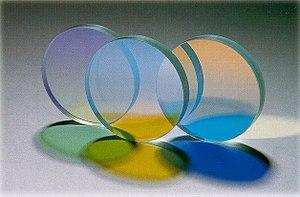
Understanding AOI is an integral part of the filter-purchasing process. For those looking to optimize AOI and cone angle requirements, we suggest you read on - from steering optics to interference filters, this blog addresses the many different influences on AOI that might not be recognizable to the naked eye. Our products ensure you get the best, most refined spectral response possible - but why not learn a bit more about the science behind this phenomenon?
Angle of incidence and cone angle
In optics, all angles are measured with respect to the normal (perpendicular to the surface). This includes the angle of incidence (AOI), angle of reflection and angle of refraction. The AOI is the average angle at which the light hits the surface. If the light beam comes in perpendicular to the surface, the AOI is zero.
Some light beams are collimated, meaning all the light is moving in the same direction These beams are not being focused or defocused. In this case, the cone angle is also zero. The cone angle describes the deviation of the AOI in a converging or diverging beam. It is often expressed as a half cone angle in a tolerance. For instance, a beam with an AOI of zero might have a distribution of angles (cone angle) of + 20 degrees. The cone of light hitting the surface will contain a total of 40 degrees centered around zero.
For steering optics (mirrors and dichroics), this can become more complicated. You may have an example where the AOI is 45 degrees with a ½ cone angle of 10 degrees (or + 10 degrees). The light hitting the surface will contain light at all angles between 35 degrees and 55 degrees. See our AOI tech notefor more information about cone angles and how they relate to f/# and numerical aperture.
Why do AOI and ½ cone angle matter for interference filters?
Interference filters work by layering thin-films of materials with different refractive indices (high and low) in an alternating pattern on a substrate. By keeping the layers and materials constant and only changing the AOI, it can be shown that the wavelength of maximum interference is proportional to the cosine of the AOI. In a bandpass filter, for example, the peak transmission wavelength will decrease as the AOI increases. Remember, cosine of zero degrees (AOI=0) is 1 and cosine of 90 degrees (parallel to the surface, AOI=90) is zero. The greater the AOI, the lower the cosine and the lower the observed wavelength.
Increasing the cone angle causes both a lowering of the center wavelength and a broadening of the spectral response. The beam described by the cone angle contains light at all the intervening wavelengths. So, the response of a 20 degree half cone angle is the response of all angles between 20 and zero added together. Because filter design includes the AOI in its optimization, it is difficult to design a filter that will work well at large cone angles.
Omega Optical has been developing new coating materials to mitigate the effect of angle on the spectral response. We can also help you to optimize the AOI and cone angle requirements for your system. Contact a member of our team today.
